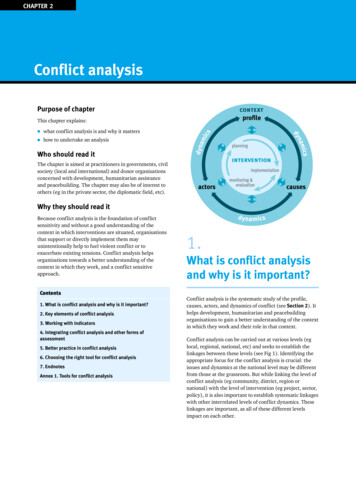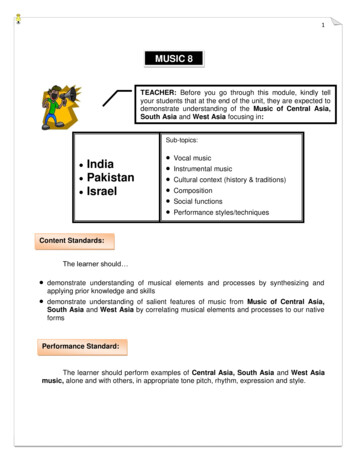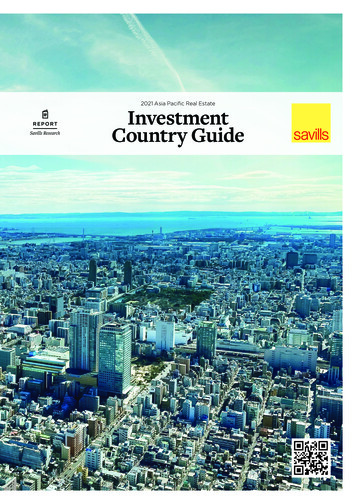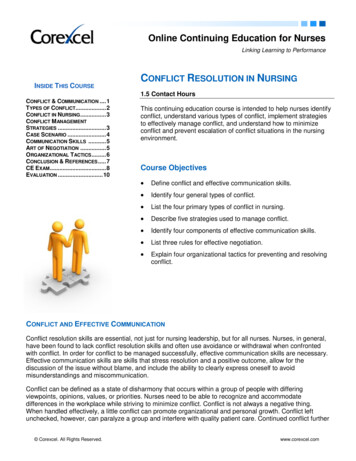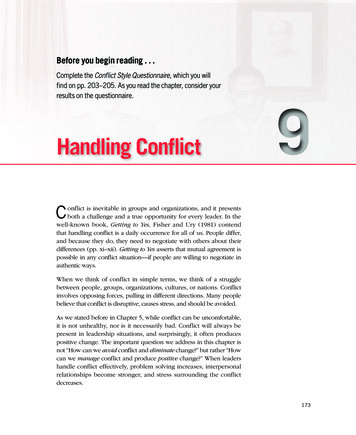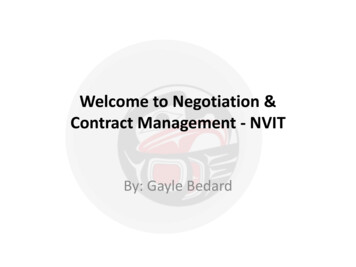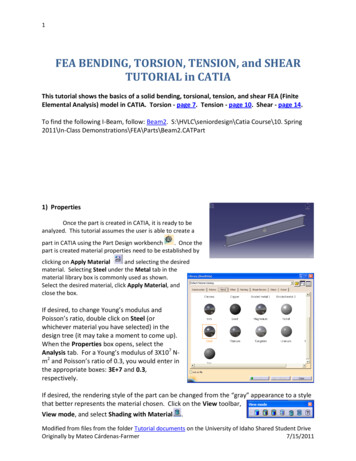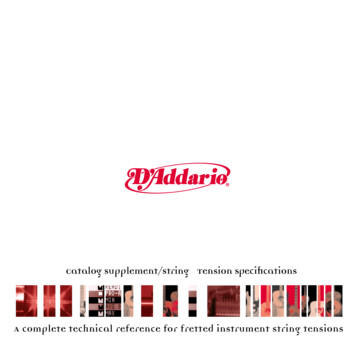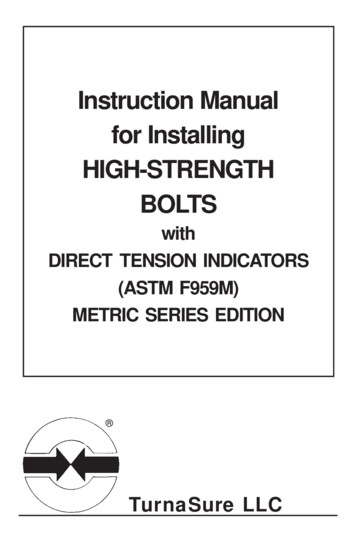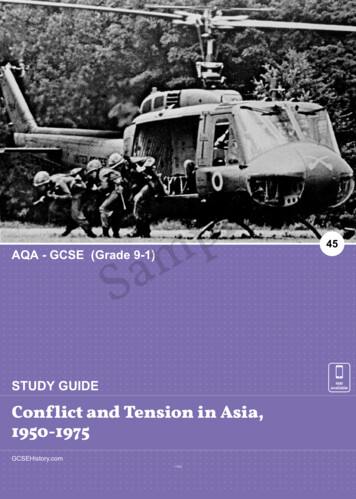
Transcription
Conflict and Tension in Asia, 1950-1975elpmaSAQA - GCSE (Grade 9-1)STUDY GUIDEConflict and Tension in Asia,1950-1975GCSEHistory.com45appavailable
45elpmSTUDY GUIDEConflict and Tension in Asia,1950-1975aSAQA - GCSEappavailablewww.GCSEHistory.com
Published by Clever Lili Limited.contact@cleverlili.comelpmFirst published 2020ISBN 978-1-913887-44-5Copyright noticeAll rights reserved. No part of this publication may be reproduced in any form or by any means (includingphotocopying or storing it in any medium by electronic means and whether or not transiently or incidentally to someother use of this publication) with the written permission of the copyright owner. Applications for the copyrightowner's written permission should be addressed to the publisher.aSClever Lili has made every effort to contact copyright holders for permission for the use of copyright material. Wewill be happy, upon notification, to rectify any errors or omissions and include any appropriate rectifications infuture editions.Cover by: United States Army Center of Military History on Wikimedia CommonsIcons by: flaticon and freepikContributors: Donna Garvey, Marcus Pailing, Shahan Abu Shumel HaydarEdited by Paul Connolly and Rebecca ParsleyDesign by Evgeni Veskov and Will FoxAll rights reservedwww.GCSEHistory.com
DISCOVER MORE OF OUR GCSE HISTORY STUDY GUIDESGCSEHistory.com and Clever Lili25AQA - GCSE26AQA - GCSE27AQA - GCSEAQA - GCSE28AQA - GCSE29AQA - GCSESTUDY GUIDESTUDY GUIDESTUDY GUIDESTUDY GUIDESTUDY GUIDESTUDY GUIDEBritain: Health and the People,c1000 to the Present DayElizabethan England, c1568–1603Conflict and Tension betweenEast and West, 1945–1972Germany, 1890–1945:Democracy and DictatorshipAmerica, 1920–1973:Opportunity and InequalityBritain: Power and the People,c1170 to the Present SEHistory.comGCSEHistory.comGCSEHistory.com35AQA - GCSE36AQA - GCSE43AQA - GCSEAQA - GCSE38AQA - GCSE41AQA - GCSE3044STUDY GUIDESTUDY GUIDESTUDY GUIDESTUDY GUIDESTUDY GUIDESTUDY GUIDENorman England, c1066–c1100Conflict and Tension:The First World War, 1894–1918Russia, 1894–1945:Tsardom and CommunismAmerica, 1840–1895:Expansion and ConsolidationConflict and Tension:The Inter-War Years, 1918–1939Britain: Migration, Empires and the People,c790 to the Present HE GUIDES ARE EVEN BETTER WITH OUR GCSE/IGCSE HISTORY WEBSITE APP AND MOBILE APPGCSE History is a text and voice web and mobile app that allows you to easily revise for your GCSE/IGCSE exams wherever you are - it’s likehaving your own personal GCSE history tutor. Whether you’re at home or on the bus, GCSE History provides you with thousands of convenientbite-sized facts to help you pass your exams with flying colours. We cover all topics - with more than 120,000 questions - across the Edexcel,AQA and CIE exam boards.GCSEHistory.com
ContentsHow to use this book. 7Ngo Dinh Diem's Government in South Vietnam . 0What is this book about? . 8The Civil War in South Vietnam. 0Revision suggestions . 10Kennedy's War . 0The Vietcong . 0TimelinesConflict and Tension in Asia, 1950-1975 . 11The Origins of the Cold WarThe Strategic Hamlet Programme . 0The End of Diem's Government . 0Johnson’s War . 0The Cold War. 14The Gulf of Tonkin. 0The Causes of the Cold War .15Operation Rolling Thunder. 0The Differences Between Capitalism and Communism.0The Tactics of the Vietcong . 0The Truman Doctrine .0The USA's Tactics Against the Vietcong in Vietnam. 0The Policy of Containment.0The Draft System. 0The Tet Offensive. 0The Conflict in KoreaThe Korean War.0The My Lai Massacre . 0The United Nations .0The Growing Peace Movement. 0elpmThe Division of Korea .0The Ending of the Conflict in VietnamNationalism in Korea .0Nixon's War. 0US Relations with China.0Vietnamisation . 0The Causes of the Korean War.0Relations with the USSR and China in the 1970s. 0The North Korean Invasion of South Korea, 1950 .0The Widening of the War into Cambodia and Laos . 0aSThe United Nation's Response to the Invasion.0The Student Movement Against the Vietnam War . 0The USA's Response to the Invasion.0The Kent State University Shootings . 0The USSR's Response to the Invasion .0The Role of the Media and TV in Influencing Public Opinion About theThe UN Campaign in South Korea.0Vietnam War. 0The Inchon Landing.0The Impact of the Watergate Scandal on the Vietnam War. 0The UN Forces' Advance into North Korea .0Political Opposition to the War . 0The Entry of China to the Korean War .0The Easter Offensive. 0General Douglas MacArthur and the Korean war .0The US Withdrawal . 0The Military Stalemate Around the 38th Parallel.0The Paris Peace Talks . 0The Peace Talks and the Geneva Accords.0The Fall of Saigon . 0The Impact of the Korean War .0The Reasons for US Failure in Vietnam . 0The Weapons Build-up.0The Impact of the Vietnam War . 0The Escalation of Conflict in VietnamThe Key Individuals of the Cold War in AsiaThe Vietnam War .0Walter Cronkite . 0French Rule in Asia Before the Second World War.0Ngo Dinh Diem . 0The Vietminh .0President Dwight D Eisenhower. 0The First Indochina War, 1946-1954.0President Lyndon B Johnson. 0Truman's War.0President John F Kennedy . 0Eisenhower's War .0Henry Kissinger. 0The Domino Theory.0General Douglas MacArthur. 0Dien Bien Phu and Its Consequences.0Ho Chi Minh . 0The Geneva Accords, 1954 .0President Richard Nixon . 0Get our free app at GCSEHistory.com
Syngman Rhee.0Kim Il-Sung .0President Harry Truman .0Glossary .17Index . 21elpmaSQuizzes, amazing exam preparation tools and more at GCSEHistory.com
HOW TO USE THIS BOOKInthis studyguide,youwill see a series of icons, highlighted words and page references. The key below will help you quicklyHowto usethisbookestablish what these mean and where to go for more information.IconsWHAT questions cover the key events and themes.WHO questions cover the key people involved.WHEN questions cover the timings of key events.WHERE questions cover the locations of key moments.WHY questions cover the reasons behind key events.HOW questions take a closer look at the way in which events, situations and trends occur.elpmIMPORTANCE questions take a closer look at the significance of events, situations, and recurrent trends and themes.DECISIONS questions take a closer look at choices made at events and situations during this era.Highlighted wordsAbdicate - occasionally, you will see certain words highlighted within an answer. This means that, if you need it, you’ll find anexplanation of the word or phrase in the glossary which starts on page 17.Page referencesaSTudor (p.7) - occasionally, a certain subject within an answer is covered in more depth on a different page. If you’d like to learnmore about it, you can go directly to the page indicated.Get our free app at GCSEHistory.com7
WHAT IS THIS BOOK ABOUT?What is this book about?Conflict and Tension in Asia, 1950 - 1975 is a wider world depth study that investigates international relations. Thecourse focuses on the causes and course of the Cold War in Asia. It considers why conflict occurred in this region, as wellas how it developed, and why it proved difficult to find a resolution to the tensions. The course examines the roles of keyindividuals and groups in influencing change, and how they were impacted by international affairs.PurposeThis study will help you to interpret the intricacies and diverse interests of different individuals and states. You willinvestigate themes such as capitalism and communism, international diplomacy, the causes and impact of warfare, andthe challenges of bringing an end to war. This course will enable you to develop historical thinking, to identify andanalyse causation and consequence, and encourage you to critically question sources.EnquiriesConflict and Tension in Asia, 1950 - 1975 is split into 3 key enquiries:Enquiry 1 examines the conflict in Korea.Enquiry 2 examines the escalation of the conflict in Vietnam.Enquiry 3 examines the ending of the conflict in Vietnam.Key IndividualsSome key individuals studied on this course include:elpmNgo Dinh Diem.Dwight D Eisenhower.John F Kennedy.Lyndon B Johnson.General Douglas MacArthur.Ho Chi Minh.aSRichard Nixon.Kim II-Sung.Harry Truman.Key EventsSome of the key events and developments you will study on this course include:The origins of the Cold War.The invasion of South Korea.The stalemate in the Korean War.The first Indo-China war.The civil war in South Vietnam.The Gulf of Tonkin incident.Operation Rolling Thunder.The Tet Offensive.The My Lai Massacre.Events at the Kent State University.The USA withdrawal from Vietnam.AssessmentThe Conflict and Tension in Asia, 1950 - 1975 course is part of paper 1 (2 hours). You should spend 1 hour on this sectionof the paper. There will be 4 exam questions which will assess what you have learned from the course.Question 1 is worth 4 marks. It requires you to examine a source and explain its meaning in its historical context.Question 2 is worth 12 marks. It requires you to examine 2 sources and assesses your ability to evaluate sourcesfor a particular purpose.Question 3 is worth 8 marks. It requires to you to explain and analyse historical events in relation to cause andconsequence.8Quizzes, amazing exam preparation tools and more at GCSEHistory.com
WHAT IS THIS BOOK ABOUT?Question 4 is worth 16 marks, plus 4 marks for spelling, punctuation and grammar. You are required to make ajudgement about the importance of an event or development in an extended response.elpmaSGet our free app at GCSEHistory.com9
elpmTHIS IS A SAMPLE.REVISION SECTION REMOVED.aS10Quizzes, amazing exam preparation tools and more at GCSEHistory.com
CONFLICT AND TENSION IN ASIA, 1950-1975Conflict and Tension in Asia, 1950-1975August - Korea is divided into 2 nations along the 38th parallel (p.0)TIMELINE19451946December - Beginning of the 1st Indochina war against the Vietminhand the Imperial French powers in Vietnam (p.0)March - President Harry Truman announces the policy of containment,1947which became known as the Truman Doctrine (p.0)1949The Cold War begins (p.14)1949 - A communist government comes to power in China and thePeople's Republic of China is established (p.0)June - Kim II-Sung launches an invasion of South Korea (p.0)1950elpmJuly - President Truman sends 15 million in aid to France to fight theVietminh, marking the beginning of US involvement in Vietnam (p.0)September - UN forces led by General Douglas MacArthur arrive inSouth Korea (p.0)October - UN forces advance beyond the 38th parallel into NorthKorea (p.0)aSOctober - China enters the Korean war to support Kim II-Sung's forces(p.0)July - Peace settlement agreed, marking the end of the Korean War(p.0)1952November - Dwight D Eisenhower is elected President of the UnitedStates and promises to end the stalemate in Korea (p.0)19531954April - Dwight D Eisenhower first articulates the concept of the'Domino Theory' (p.0)May - France surrenders to the Vietminh after defeat at the battle ofDien Bien Phu (p.0)July - The Geneva Accords divides Vietnam at the 17th parallel intoNorth Vietnam and South Vietnam (p.0)January - Dwight D Eisenhower sends the first shipment of military aid1955to South Vietnam (p.0)1957July - Civil war breaks out in South Vietnam in opposition to Ngo DinhDiem's government (p.0)November - John F Kennedy elected President of the United States1960(p.0)December - The Vietcong is formed (p.0)1962January - There are now 11,000 US military advisors in Vietnam (p.0)Get our free app at GCSEHistory.com11
CONFLICT AND TENSION IN ASIA, 1950-19751962 - Diem introduces the Strategic Hamlet Programme, supportedby Kennedy (p.0)November - Ngo Dinh Diem is assassinated (p.0)1963November - John F Kennedy is assassinated. Lyndon B Johnsontakes over as President of the United States (p.0)1964February - Beginning of Operation Rolling Thunder (p.0)August - Gulf of Tonkin Incident (p.0)1965October - There are anti-war protests in over 90 cities across the USA(p.0)December - There are now 200,000 US combat troops in Vietnam (p.0)1967April - The Tet Offensive (p.0)December - The Vietnam war now costs the US 30 billion a year;there are 500,000 US troops in Vietnam (p.0)elpmMarch - My Lai Massacre (p.0)November - Richard Nixon is elected President of the United States(p.0)19681969aSApril - Invasion of Cambodia (p.0)November - Nixon announces the policy of Vietnamisation (p.0)1970May - Kent State University protest shootings (p.0)January - Paris Peace Accords signed, marking an end to theVietnam war (p.0)1971February - Invasion of Laos (p.0)1973March - The last US troops leave Vietnam (p.0)12Quizzes, amazing exam preparation tools and more at GCSEHistory.com
CONFLICT AND TENSION IN ASIA, 1950-1975elpmaSGet our free app at GCSEHistory.com13
THE COLD WAR'Although the shooting war is over, we are in the midst of a cold war which is getting warmer.'Bernard Baruch, 1947What was the Cold War?The Cold War was a state of hostility that existed between the USSR and the USA in the second half of the 20th century.What is the definition of a cold war?A cold war is a conflict in which there is no direct fighting between the two sides. It is fought through economic andpolitical actions.When was the Cold War?The Cold War lasted from 1945 to 1991.Who was involved in the Cold War?The Cold War was between the USA and its allies, and the Soviet Union, its satellite states and its allies.elpmWhat were the long-term causes of the Cold War?There are 7 main reasons the Cold War happened:In October 1917, the Bolsheviks seized power in Russia. By 1921 they had created the first communist state. They wereanti-capitalism and wanted to spread the communist revolution across the world.America and Britain did not trust the USSR as Russia had withdrawn from the First World War in 1917, despite beinga member of the Triple Entente with Britain and France.aSThe USSR did not trust the USA, France and Britain because they sent troops to fight against the Bolsheviks in theRussian Civil War.In the 1920s, the USA suffered from the First Red Scare and was hostile towards the USSR.The USSR was angry it was not recognised as a country by the USA until 1933.The relationship between the USSR and the West deteriorated before the Second World War. The Soviet Union wasangry at not being invited to the Munich Conference in 1938.When the USSR signed the Nazi-Soviet Pact in 1939, Britain and France were horrified.How was the Cold War fought?The Cold War was fought in 7 key ways:Propaganda.Spying or espionage, such as using spy planes to take photographs.An arms race to have the most developed weapons, particularly nuclear missiles.A space race competing for success in space, such as being the first nation to put a man on the moon.Financial aid or loans to other countries to gain their support.Proxy wars, where the USA and the USSR became involved in conflicts in other countries. An example is the KoreanWar (p.0) of 1950-53.Threats made by either side.What created tension between the Soviet Union and the USA at the beginning of the Cold War?The ideological differences between the superpowers created tension between them. The Soviet Union supportedcommunism, whereas the USA and Britain were capitalist countries.14Quizzes, amazing exam preparation tools and more at GCSEHistory.com
What were the different ideologies in the Cold War?The Cold War was a result of ideological differences between the two sides:The USSR was communist. Communism is a system where there is no private ownership of land, property orbusiness. The aim is to achieve economic equality for the benefit of the people through central control of the stateeconomy.The USA was capitalist. Capitalism is a system where individuals are free to own land, property and businesses tocreate wealth and accept there will be economic inequality as a result.Why were the USA and the USSR considered superpowers during the Cold War?The USSR and the USA were considered to be superpowers because they possessed 3 key things:Massive military might, including nuclear weapons.Economic might.The ability to dominate other countries.Why was Stalin distrustful of Truman at the beginning at the Cold War?Joseph Stalin was distrustful of Harry S Truman for 3 key reasons:elpmTruman was anti-communist.He tried to control the Potsdam meeting.He successfully tested the atomic bomb without consulting Stalin and used it in the Hiroshima and Nagasakibombings in the days after Potsdam.Why did Britain ally closely with the USA at the beginning at the Cold War?aSBritain was concerned about communism spreading. The nation's economy was severely impacted after the SecondWorld War so it couldn't act against the Soviet Union alone.Did you know: The first known mention of the term 'Cold War' was made by English authorGeorge Orwell in a 1945 essay titled, 'You and the Atomic Bomb'.The first known mention of the term 'Cold War' was made by English authorGeorge Orwell in a 1945 essay titled, 'You and the Atomic Bomb'.THE CAUSES OF THE COLD WAR'There are at the present time two great nations in the world the Russians and the Americans Their starting point is different and their courses are not the same, yet each of them seems markedout by the will of Heaven to sway the destinies of half the globe.'Historian Alexis de Tocqueville, 1831Who caused the Cold War?Historians debate whether the USA or USSR bore greater responsibility for the outbreak of the Cold War (p.14).How did the USA cause the Cold War?Some historians argue the USA was mainly responsible for the start of the Cold War (p.14) for 6 key reasons:The Marshall Plan, the Truman Doctrine (p.0), the policy of containment and the creation of NATO were seen asaggressive moves.Get our free app at GCSEHistory.com15
President Truman was openly anti-communist, which caused greater tension. His relationship with Stalin was muchworse than that of Roosevelt, his predecessor.The USA didn't inform the Soviets about their work on developing the atom bomb. The Soviets found out throughtheir spies and felt betrayed.Stalin was not consulted over the formation of Trizonia or the adoption of the Deutschmark, despite agreement thatdecisions over Germany would be made jointly.Stalin saw the USA's refusal to leave West Berlin as a threat.Both sides participated in the nuclear arms race.How did the USSR cause the Cold War?Some historians argue the USSR was mainly responsible for causing the Cold War (p.14) for 6 key reasons:Stalin went against some of the promises he made at Yalta, such as occupying Poland and refusing to allow easternEuropean countries to have free elections.Instead of free elections in eastern Europe, Stalin ensured communist puppet governments - which he could control- gained power. This happened in Czechoslovakia, Poland, Hungary, Romania, Bulgaria and East Germany. This wasseen as a threat to capitalism.The Red Army's occupation of eastern Europe was seen as a threat, and an attempt to control the whole of Europe.Comecon, Cominform and the Warsaw Pact were seen as aggressive moves.elpmThe Berlin Blockade was an extremely aggressive act.Both sides participated in the nuclear arms race.aSUSE OUR APP: Visit GCSEHistory.com/CleverLili.com AND CHECKOUT OUR APP.THIS IS A SAMPLE.REMAINING PAGES REMOVED.PLEASE PURCHASE THE BOOK FOR FULL CONTENT.16Quizzes, amazing exam preparation tools and more at GCSEHistory.com
GLOSSARYGlossaryACivil rights - the rights a citizen has to political or social freedoms,such as the right to vote or freedom of speech.Aggression - angry, hostile or violent behaviour displayed withoutprovocation.Agriculture - an umbrella term to do with farming, growing cropsor raising animals.Alliance - a union between groups or countries that benefits eachmember.Allies - parties working together for a common objective, such ascountries involved in a war. In both world wars, 'Allies' refers tothose countries on the side of Great Britain.Ammunition - collective term given to bullets and shells.Civilian - a non-military person.Claim - someone's assertion of their right to something - forexample, a claim to the throne.Colonies, Colony - a country or area controlled by anothercountry and occupied by settlers.Communism - the belief, based on the ideas of Karl Marx, that allpeople should be equal in society without government, money orprivate property. Everything is owned by by the people, and eachperson receives according to need.Communist - a believer in communism.Amputate, Amputation - to surgically remove a limb fromsomeone's body.Conference - a formal meeting to discuss common issues ofinterest or concern.Armistice - an agreement between two or more opposing sides ina war to stop fighting.Artillery - large guns used in warfare.Conscription - mandatory enlistment of people into a stateservice, usually the military.Assassinate - to murder someone, usually an important figure,often for religious or political reasons.Containment - meaning to keep something under control orwithin limits, it often refers to the American idea of stopping thespread of communism.Assassination - the act of murdering someone, usually animportant person.Cooperate, Cooperation - to work together to achieve a commonaim. Frequently used in relation to politics, economics or law.elpmAttrition - the act of wearing down an enemy until they collapsethrough continued attacks.BaSCorrupt - when someone is willing to act dishonestly for theirown personal gain.Coup - a sudden, violent and illegal overthrow of the governmentby a small group - for example, the chiefs of an army.Booby traps - seemingly harmless devices concealing somethingthat will kill, harm or surprise. Especially in warfare, booby trapswere often set off by a wire and contained explosives.Culture - the ideas, customs, and social behaviour of a particularpeople or society.Boycott - a way of protesting or bringing about change by refusingto buy something or use services.DBribe, Bribery, Bribes - to dishonestly persuade someone to dosomething for you in return for money or other inducements.Buffer - a protective barrier.CCampaign - a political movement to get something changed; inmilitary terms, it refers to a series of operations to achieve a goal.Capitalism - the idea of goods and services being exchanged formoney, private ownership of property and businesses, andacceptance of a hierarchical society.Deadlock - a situation where no action can be taken and neitherside can make progress against the other; effectively a draw.Defect - the act of defection; to leave your country or cause foranother.Demilitarised - to remove all military forces from an area andforbid them to be stationed there.Democracy - a political system where a population votes for itsgovernment on a regular basis. The word is Greek for 'the rule ofpeople' or 'people power'.Democratic - relating to or supporting the principles ofdemocracy.Casualties - people who have been injured or killed, such asduring a war, accident or catastrophe.Deploy - to move military troops or equipment into position or aplace so they are ready for action.Catholic - a Christian who belongs to the Roman Catholic Church.Discriminate, Discrimination - to treat a person or group ofpeople differently and in an unfair way.Ceasefire - when the various sides involved in conflict agree tostop fighting.Censorship - the control of information in the media by agovernment, whereby information considered obscene orunacceptable is suppressed.Dispute - a disagreement or argument; o
October - China enters the Korean war to support Kim II-Sung's forces (p.0) November - Dwight D Eisenhower is elected President of the United States and promises to end the stalemate in Korea (p.0) July - Peace settlement agreed, marking the end of the Korean War (p.0) April - Dwight D Eisenhower first articulates the concept of the 'Domino .
